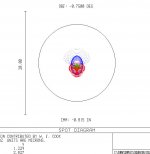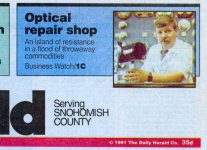A further corporate point, referring to Bill's point about 'going the extra mile..' having been loosely involved with an educational programme including the study of corporate strategy, there are a number of models that identify this factor as being key to securing a company's core, repeat custom, and the encouragement of 'word of mouth' marketing. That is of course in these modern times, when such things have to be studied and modelled, rather than just done because services were more personal, perhaps smaller-scale and bespoke.
The number of times the Swarovski after-sales is mentioned as a compelling factor for buying its products is a case in point.
Hi, Paddy:
That Glorious “Extra Mile.”
“Success is not the key to happiness. Happiness is the key to success. If you love what you are doing, you will be successful.” — Albert Schweitzer
I was repeatedly told I couldn’t make any money doing things the way I did—going that extra mile. But, in 1991 my way was selected to fill the business section of The Herald of Everett, Washington, a town 30 miles to the north. Three years earlier Captain’s had 8 binoculars in a cabinet—some junk—but by the time the article came out, my shop was on its way to becoming a destination store for “all things optical” on the west coast, I was getting repair work from across the country, was soon to have my own floor with a Lynnwood location in the works. And did I do it by the usual method of sucking up to the corporate powers that be?:
“When it comes to optics, think Bill Cook. ... Bill is not out to protect brands and factories when they continually mislead customers about their products. Instead, he tells it like it is—straight and honest—EVEN WHEN MANUFACTURERS GET UPSET WHEN THEY HEAR THE TRUTH.”—Alan Hale, Co-founder and former CEO of Celestron.
Alan knows; Celestron was in my crosshairs more than once.
I often get tarred and feathered on binocular forums for being self-serving, condescending, arrogant, and worse. But I would like to comment on those things.
1) If you’ve done it, it “ain’t braggin’." —George S. Patton and a few dozen others from baseball to business.
2) “Self-serving?” Never! Quite the opposite. I’ve used what I have known to help others. I was the first to openly fight Steiner’s Auto-Focus fraud—with the nerve to call it what it was—and have continued to fight to get people to understand what binocular “collimation” is and is not, with a thousand lesser battles strewn in between. I sometimes struggle to help my neighbor even as some gather to scar my back—as they have sometimes done on this forum.
A Better World?
Research shows that today’s average 20-year old will have “3 careers and 8 jobs” before leaving the workforce. Tell me, how likely is it such a person—thinking mostly of financial reward—will develop the expertise in any field to be able to offer solid advice of that field to his neighbor, should they request it?
Long before I knew of the Schweitzer quote, I followed the mantra:
“Go into a profession you love and you will never have to ‘work’ a day in your life.” Of, how true that turned out to be. And wouldn’t the world be a better place if more people tried it?
Going the extra mile is more pleasant
AND profitable if you look outside yourself to see the scenery along the way, enjoy helping others, and count your blessings with every step. :cat:
Bill





